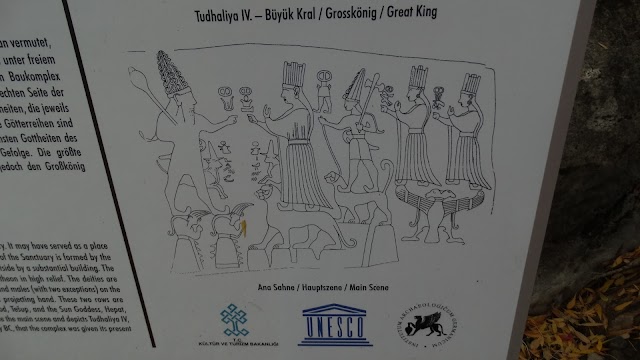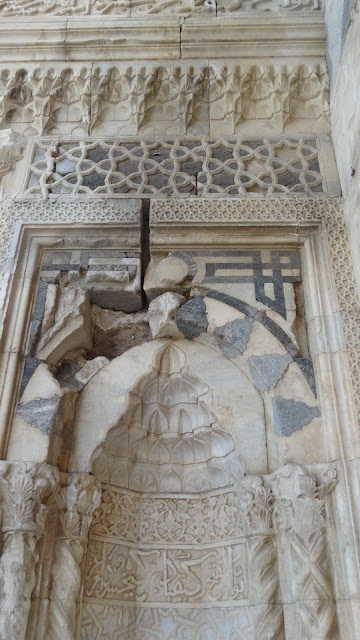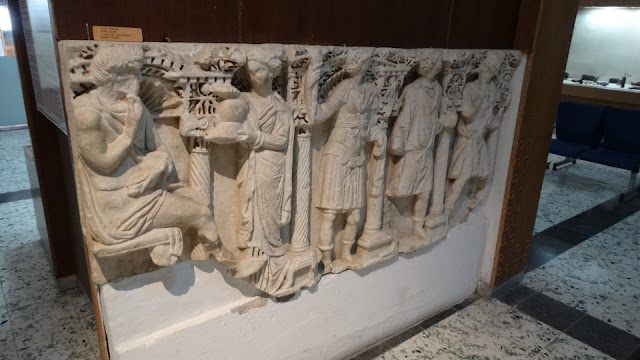Derbe - A city visited by Paul and Barnabas on their First Missionary Journey
 |
| https://graceofourlord.com/2012/10/15/acts-14-paul-and-barnabas-at-iconium-and-lystra/ |
Derbe (Greek: Δέρβη, Turkish: kerti höyük) was an ancient city in southern Galatia (also Lycaonia). It was the end destination of Paul and Barnabus' First Missionary Journey, dated between 44-45 AD.
The Apostles spent an undetermined amount of time there, and when they left, they retraced their steps all the way back through Lystra, Iconium, and Pisidian Antioch and finally southward to the coastal city of Attalya, close to where they began the trip, on the Mediterranean coast. [Attalya is close to the initial "P" of "Pamphylia" on the map, above.] They then sailed back to Antioch of Syria. The entire journey was estimated to have taken approximately three years.
To me, one of the fascinating elements of this journey is the fact that the disciples were the first to take the Gospel to these geographical areas and people groups that had never heard of Christ - except perhaps through third person accounts (i.e. people sharing accounts from the "outside world" such as Ephesus or other cities on the Mediterranean coastline). Most native people had no previous interaction with representatives of this "new faith."
Judaism, on the other hand, had a much earlier presence in Asia-Minor, dating back into the pre-Christian era.
"The first synagogues in Asia Minor were apparently built at that time. Important evidence of the distribution of Jews in Asia Minor has been preserved in the Roman circular of 139 B.C.E. to the Hellenistic cities and states. It mentions Caria, Pamphylia, and Lycia as places of Jewish settlement (I Macc. 15:23). Cicero's account of the confiscation of the money which the Jews of Pergamum, Adramythion, Laodicea, and Apamea had designated for the Temple in Jerusalem, during the governorship of L. Valerius Flaccus, provides additional evidence of the spread of Jews in Asia Minor."
And, just in case you're interested in more specific information:
"...by accounts of the Jewish communities in the New Testament – in Acts and in Paul's Epistles. According to these inscriptions, Jews were settled in the following regions of Asia Minor: Ionia, Mysia, Lydia, Caria, Lycia, Phrygia, Lycaonia, Cappadocia, Galatia, Bithynia, Paphlagonia, Pisidia, Cilicia, and other localities."
Source: https://www.jewishvirtuallibrary.org/asia-minor
+++++
My picture below shows the current state of the city of Derbe!
 |
| Cliff_Emerson |
This is what remains of the city - a tell, or large mound of earth and rock and a few tile fragments on the surface - rising above a flat agricultural plane. The mound's dimensions are roughly 450 x 250 meters (1476 x 820 feet).
Prior to the visit, I made a short stop at the Historical Museum in Karaman, 30 km. to the southwest, and looked for one of the important inscriptions on a stone in their collection that helped to positively identify the site of Derbe. [Scroll down to see this description.]
And before that, I drove by a similar mound of Lystra of Lycaonia near the village of Hatunsaray about 30 km. to the northwest. (Click here to see Acts 15:8-20)
Click here for my blog post about Lystra.
 |
| (I'm in the process of tracking down the reference for this graphic.) |
+++++++++++Derbe is mentioned four times in the Acts of the Apostles:
Acts 14:6, 14:20, 16:1 and 20:4
The Apostle Paul visited the city three times.
Interestingly, Derbe is one of two cities mentioned in the Acts of the Apostles where the message of the Gospel seems to have been positively accepted by most of its inhabitants. The other city is Beroea, located between Achaia and Macedonia, in Greece.) In both, the Apostle Paul was apparently welcomed by their inhabitants without controversy or conflict.
#####
When driving out to the remote site of Derbe, you will travel on agricultural roads with few people and no traffic.
The Turkish farmers harvest sugar beets and load them onto these trailers - often 2-3 pulled in a train behind a tractor - to take them to gathering stations.
When driving by a farmstead, I saw a machine for chopping up sugar beet tops or alfalfa.++++++
Paul and Barnabas came to Derbe after fleeing a disturbance at Lystra about 40 miles (65 km) to the west. There, Paul survived a stoning and was dragged out of the city. (Acts 14:8-20) Shortly thereafter, he was healed and returned to his mission of sharing the Gospel in neighboring cities.
Video: It was raining lightly when I drove out to Derbe. Notice the mound of the city increases in size on the right side of the road as I get closer.
I made my journey to Derbe in a rental car, and was fortunate to run into a fellow in a village who had just returned from England, and he gave me great verbal directions in English (rare in rural Turkey).
Below, you can see the only road sign on my entire journey. It would have been smarter for me to have found out the Turkish name for Derbe (Kertihöyük), and have writen it down on a piece of paper to show to the local people for directions.
 |
| cliff emerson |
Derbe was connected to Laranda (Karaman) and Lystra by an existing Roman road.
 |
| http://imperium.ahlfeldt.se |
The excellent map above (single-click to enlarge) shows the existence of Roman Roads that have been verified in Asia Minor and elsewhere in the Roman Empire. This particular screen shot shows the Roman cities of Derbe (green peg), Iconium, Lystra, Laranda (today: Karaman), and the Mediterranean Sea. Roman Roads are marked in red.
Compare that area with the region around "LYCAONIA" in the map below.
Brief Review: Tracing Paul's journey by using this map.After coming in from the island of Cyprus by ship, Paul, Barbabus and John Mark landed at Perga. A disagreement with John Mark led to a splitting of the parties, and John Mark returned to Jerusalem on his own. Thereafter, Paul and Barnabas most likely hiked northward across the rugged Taurus Mountains to Pisidian Antioch (located at today's Yalvaç) and then eastward to Iconium (modern Konya - notice the similarity in pronunciation of the last city).
 |
| https://www.anatolianroads.org/roads/ |
This is what a Roman Road in Anatolia looks like today, not unlike its earlier appearance in the days of Paul. Pretty bumpy!+++++
Next, at Lystra, on their third of four stops, Paul was stoned and left for dead. Immediately thereafter - on the following day - he and Barnabas decided to travel on to Derbe.
Paul's Future Trips through the Area:
Paul passed through Derbe on two subsequent journeys in a westerly direction through Asia Minor (Acts 16:1; Acts 20:4)
 |
| cliff_emerson |
In case you want to drive to Derbe (Kerti Höyük), it is located 12 air miles (19 km) NE of Karaman. Good luck! I recommend taking a bus tour! I personally don't read or speak Turkish, and unless you're a seasoned and hearty traveler, don't go for the rental car option, especially by yourself.  |
| cliff_emerson |
Potsherds (ceramic tile pieces - usually orange in color) scatted on the ground with small rocks.Video above: Debris field on the hillside of Derbe +++++
Even though explorers started to look for Derbe in 19th century, its location wasn't discovered until 1957 when researchers found a statue base with an inscription mentioning Derbe.
Today, there are no significant settlements nearby - only cultivated and grazing land.
Pottery pieces and other small objects found at the site are displayed in the museums in Karaman and Konya. A good reference is Mark Wilson's book: Biblical Turkey.
On the flanks of the hill where the city remains, I found a shepherd and his flock.
 |
| cliff_emerson |
You may certainly be disappointed in the site of Derbe because it offers basically nothing to see. Just be sure to climb the mound and look for artifacts as you go (do not keep them, however), inspect the archaeological excavations on the top, and get a panoramic view of the landscape in all directions. The day I visited, the weather was rather hazy.
 |
| cliff_emerson |
The famous Roman geographer, Strabo, gives us clues about the location of Derbe in his Geographica book; volume XIII, page 569. The history of the site dates back to local kingdoms in Anatolia. Later - in 1st century BC, Romans came and took over the territory, so it became a part of Galatia.
After the original spread of Christianity, the city of Derbe was ruled for several centuries at first as part of the Roman Empie, which later became the Byzantine Empire. Arabs invaders invaded Asia Minor and destroyed the city in 7th century AD. Its inhabitants finally abandoned Derbe around the 10th century. After Seljuk Turks (also Muslims) settled in the region from 11th century on, a small village was founded in the area.
Christianity, as we know it under the auspices of Byzantium, was basically annihilated - that is, wiped-out. Henceforth, believers had to either convert, live in dhimmitude, hide or flee. In this part of the world - throughout the neighboring area of Cappadocia - there are plenty of manifestations of this dilemma observed in the countryside - deep holes in the ground (multi-storied) where people were forced to live, or caves dug out of the hillsides or canyons, often perched high above the ground where they could not be attacked. [Look for such a post from me in the future that features these items.]
 |
| cliff_emerson |
View of the top of the mound - archaeological excavations.
Derbe was an important center of Christianity in this geographical area during early Byzantine rule. They sent bishops to represent Derbe at the Ecumenic Councils of Ephesus in 413, Chalcedon (today's Kadiköy - located in the Asian district in Istanbul) in 451, and Constantinople in 692.
After facing difficulties in Lystra, Paul “...went on with Barnabas to Derbe. After they had proclaimed the good news to that city and had made many disciples, they returned to Lystra, then on to Iconium and Antioch” (Acts 14:20-21).
Using the Barrington Atlas of the Greek and Roman World, Mark Wilson notes the great distances covered in this brief statement above:
Travel from:
- Derbe to Lystra (via Laranda) 81 miles
- Lystra to Iconium 21 miles
- Iconium to Pisidian Antioch 92 miles
- Paul and Barnabas then turned back toward Perga over the rugged Taurus Mountains to return to the Anatolian coast, and sailed to Antioch of Syria.
- During the 2nd Missionary Journey in Acts 16, Paul returns to the area with Silas, where they meet the disciple Timothy.
https://www.biblicalarchaeology.org/daily/news/derbe-excavations-explore-pauline-site/
Incidentally, Gaius, a disciple, was converted and later joined Paul's team on the third journey that went through the region (see Acts 20:4).
An interested note: Paul and Barnabas journeyed back to Lystra and Iconium and strengthened the small flock of believers in each place before heading home. They didn't avoid these places even though they faced persecution there.
+++++
The site of Derbe remained undiscovered and unverified until the 20th century. It is one of the three non-excavated New Testament city sites buried under a tell (a large mound; Turkish: höyük) in modern Turkey. (The other two cities, Lystra and Colossae, are located further to the west.)
In 1956 M. Balance discovered an inscription dated at 157 AD at the present site, Kerti Höyük, northeast of Karaman that mentions the New Testament city of Derbe. It is located at the Konya Archeological Museum.
In 1967 B. Van Eldersen discovered another inscription nearby that names a bishop of Derbe and confirms the biblical site's existence at the present mound in the 4-5th Century. It reads: "...the most God-loving Michael, bishop of Derbe." This rock with its inscription is now displayed at the Archeological Museum in Karaman (see it pictured below).
References:
https://www.sevenchurches.org/asia-minor-archaeology/
Here's an online news source from back in 2013:
Derbe Excavations Explore Pauline Site - Bible and Archaeology News Hurriyet Daily News
Noah Wiener September 06, 2013
The Derbe Excavations
Excavations near Karaman in southern Turkey have begun to uncover remains from ancient Derbe, a site of Paul’s evangelizing in Acts 14-16. According to Dr. Mark Wilson,* director of the Asia Minor Research Center in Antalya, Turkey, Derbe was one of the only known New Testament sites left unexcavated in Turkey, along with Colossae and Lystra.
Karaman governor Murat Koca told Hurriyet Daily News that “We think the place where he [Paul] lived is this tumulus. Works are continuing to prove this fact. This excavation has much importance to Karaman, because if we can find a work from the early period of Christianity, this place will be an important center for faith tourism.”
https://ferrelljenkins.blog/2007/06/01/iconium-pisidian-antioch-attalia/
Derbe Excavations Explore Pauline Site
https://www.biblicalarchaeology.org/daily/news/derbe-excavations-explore-pauline-site/
Below is a picture of an interesting artifact and comment from a visitor to the Derbe site:
 |
| https://bramanswanderings.com/2014/05/14/tells-tell-a-tale/ |
I had many similar experiences during my journeys in Turkey - picking up objects: I would seriously like to collect such artifacts, but felt compelled to leave them on the site where I found them. You should be ethical and honest with such items - archeologists need these artifacts to map and interpret the area. I also could not imagine the kind of hassles you would experience at the border or airport when leaving the country with them in your possession! It's illegal!
+++++
Following are some pictures from the fortress in Karaman and the Karaman Archaeological Museum:
City Fortress: (closed to the public. I'll have look for research on this structure.)
 |
| cliff_emerson |
King Barbarossa and his troops came through this city on the way to the south in a Crusade.
Interesting artifacts observed during my visit to the Archaeological Museum in Karaman.
Sarkophage
This is the stone that helped to establish the location of the site of Derbe being in its current location. The inscription mentioned Bishop Michael of Derbe.This stone has some Christian markings that are hardly visible - a large cross inside a circle on the right side where the crack is located.
In intriguing piece that portrays what may be Mary and the Christ Child in the top row, center panel.
A cute, dumpy saint holding a bunch of grapes.
Above, a video I made while leaving the area that afternoon, traveling further toward the east.
To see a continuation of this trip - to visit the Hittite Carvings at Ivriz post - click here.
To return to the Table of Contents, click here.


































































